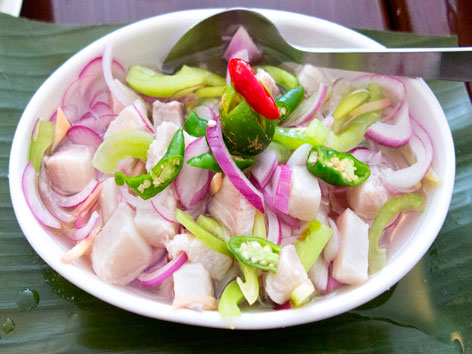Ethiopian Chicken Stew (Doro Wett)
Ethiopia
amantour
guides you to the best local dishes & drinks in
125+ cities. See map now



.jpg) Going somewhere and wish you could take all of a city’s Eat Your World info with you? With EYW’s Kindle and City Guides, you can! Don’t miss out on any local foods or drinks during your next trip.
Going somewhere and wish you could take all of a city’s Eat Your World info with you? With EYW’s Kindle and City Guides, you can! Don’t miss out on any local foods or drinks during your next trip.
EYW wants your food photos!

EYW wants your food stories!
Hey guys I am a traveler who loves to explore different places around the world. I often visit outside of Canada, So whenever I have to travel around the world I always book my flight tickets from the... Read more


What: Kinilaw, also called kilaw (kee-nee-lahw”; “kee-lahw”), is raw, cubed fish in a vinegar-based dressing, usually eaten as an appetizer. It’s also the ever-important “kil” in the term sutukil (“soo-too-kill”), a favorite local pun (“shoot to kill”) and a portmanteau for how Cebuanos traditionally cook: sugba (grilling), tuwa (simmering in broth), and kilaw (eating raw). The closest comparison for kinilaw is ceviche, except ceviche uses citrus fruit like lemons or lime to dress the seafood while kinilaw uses the ubiquitous coconut vinegar, plus garnishes like garlic, onions, ginger, and chiles. Actual connections to South American ceviche are vague, as early accounts of the Spanish explorers and missionaries in the Philippines indicate that the natives were already consuming a lot of fish, some in a style called cquilao (also pronounced “kee-lahw”) that was likely a precursor of this dish. Kinilaw hasn’t changed much over the years, with the best versions relying on good vinegar and fresh raw fish—connoisseurs say it should be “washed,” not soaked, in the vinegar, turning the pink flesh white and just slightly opaque. Fortunately, both of these things are abundant in Cebu, even on its smallest inhabited islands.
Where: Kaona Grill (032-260-1565; Wilson St., Lahug, map) serves traditional kinilaw (Php 135) as well as a version called sinuglaw (“see-noog-lahw”), yet another joined-together word, this time of sinugba (meaning grilled) and kinilaw. (For that dish, grilled pork cubes and fresh coconut milk are mixed with the kinilaw to add a rich, meaty dimension to the fish.)
Good to know: Despite the lush vegetation and tree cover, Kaona’s al fresco areas can get boiling hot during the day. Opt to dine in the air-conditioned room, or hit the place up at night when the garden cools down.
When: Daily, 11am-2pm; 6pm-midnight
Order: Pictured is kinilaw with tanigue (Php 135), a type of local mackerel that we prefer for its freshness. (Kaona Grill also offers kinilaw using tuna, usually yellowfin, but it is likely frozen and flown in.) Our kinilaw arrived quickly, looking appropriately pink and accompanied by thinly sliced bombay (“boom-bye,” the local term for purplish-red onions), slivers of ginger, slices of green tomatoes, green finger chiles, and limonsito with bird’s eye chile on top. It had a little sweetness to it, which we didn’t love—we suspect a dash of sugar made its way into the vinegar—but otherwise, the kinilaw was an excellent starter for a meal that might include grilled liempo (pork belly), crispy pata (deep-fried pig trotter), and buttered grilled prawns.
Alternatively: Food-court kinilaw does exist, but it generally sits out (turning sadly opaque) for hours, so it won’t be the best representation of the dish. Opt for Filipino/Cebuano-style restaurants that will create your kinilaw upon order, like Boosog Lasang Pinoy restaurant (63-32-238-1600; The Gallery, Juan Luna Ave., Mabolo, map), where sinuglaw is also served.
©2025 Eat Your World, LLC - All Rights Reserved